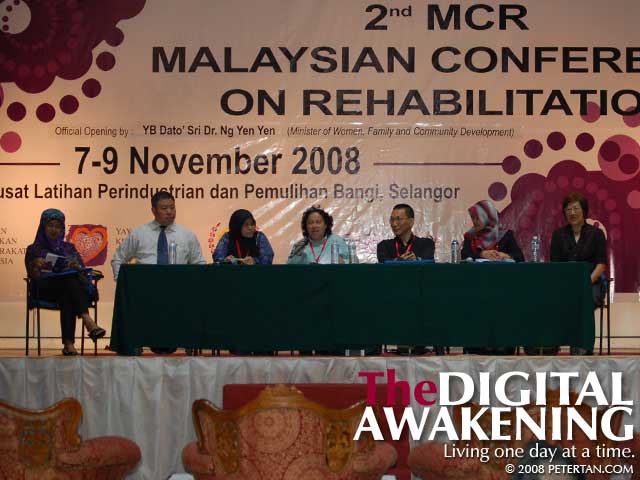
Peter Tan speaking at the 2nd Malaysian Conference on Rehabilitation.
Photo by Wuan.
My second presentation for the 2nd Malaysian Conference on Rehabilitation at the Pusat Latihan Perindustrian dan Pemulihan Bangi (PLPP Bangi) was titled “Rights-Based Advocacy on Disability in Malaysia: An Overview and the Way Forward.” It was for the Special Interest Groups concurrent session on “Social Advocacy on Disability Issues.”

In advocating for equality, the first issue that we need to resolve is to redefine disability. I asked if disability is caused by the condition of the person or is it caused by the environment? At the same time, I challenged the use of the term “persons with disability” and its Malaysian Language equivalent “orang kurang upaya” to refer to disabled people. “Orang kurang upaya” means persons with lesser abilities. To the general public, it is just a matter of terminology but it matters a lot to me as the person who is being referred to.

The other matters that I brought up were that there is a need for a paradigm shift from charity-based to rights-based advocacy, inclusion of disabled people as stake holder in all levels of decision making and resolving issues using a holistic approach rather than on a piecemeal basis. The following is the abstract of my presentation:
Abstract
Rights-Based Advocacy on Disability In Malaysia:
An Overview And The Way ForwardThe disability advocacy movement in Malaysia has a tattered history of modest victories and great failures. Three decades or so of advocacy and activism have not succeeded in ensuring the equalization of opportunities for disabled people. Disability is considered a problem of the minority and other people’s problems. Resolving disability-related problems are deemed extras that need money and do not benefit the majority. This essay explores the reasons behind those perceptions and how we can learn from past mistakes to effectively move the government, corporations and society to change their mindsets and create an inclusive environment that benefits everyone.
Below were the topics that my fellow speakers presented:
The Need for “Bottom-Up” Approach in the Implementation of Policies Related to Persons with Disabilities in Malaysia
Associate Professor Dr. Tiun Ling Ta
Universiti Sains Malaysia
Empowering People with Intellectual Disabilities
Ms. Khor Ai-Na
Executive Director of Asia Community Service
Media – Friend or Foe
Ms. Mary Chen
Editor, Challenges
JICA Project on Support for Persons with Disabilities in Malaysia
Mr. Hideo Tsukamoto
Assistant Resident Represnetative, JICA Malaysia
Self-Advocacy: Towards an Interdependent and Inclusive Community
Ms. Teh Hooi Ting and Ms. Yeo Swee Lan
United Voice
Promoting Accessible Public Transport – Meeting the Needs of Disabled People and All
Ms. Christine Lee
BEAT
Challenges and Success Stories of Advocacy in Diverse Communities in Sarawak
Mr. Francis Johen Adam



